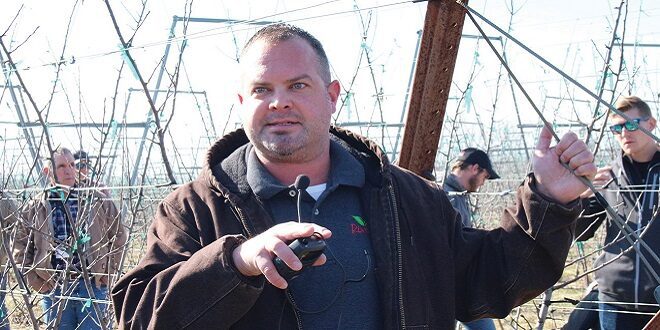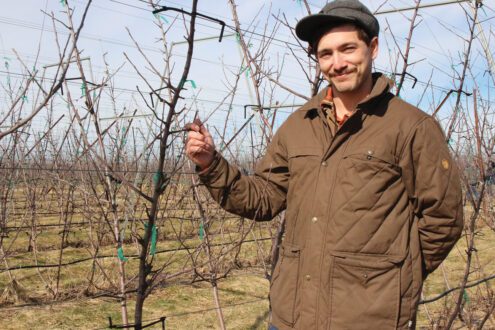

Aug 22, 2023Organic Grower: Apple growing profitable, but challenging
It’s all in the details when growing organic apples. Growers saw the challenges firsthand during the International Fruit Tree Association’s 66th annual conference and tours in Grand Rapids, Michigan.
At a stop during the February tour, at Riveridge Produce Marketing in Grant, account manager RJ Simons said the company’s aim is to supply a growing demand for organic apples.
“When customers go in and they see local organic products one week, and then next week it’s from another region, that’s just not great,” he said.


Organic apples can generate 25%-30% greater revenue than conventional apples in the fresh market — and often creates double the price in the processing market.
Riveridge has partnered with local organic grower Kyle Rasch to increase volume and provide the consistent supply local retailers are seeking.
Rasch, part of Rasch & Sons Orchards, Greenville, said he keeps a constant eye on weather, biofix solutions, pest trapping and spray timing with materials that frequently only work at a certain stage of production.
“With the challenges of insects, you have to take a proactive approach,” Rasch said while standing amid two blocks of Riveridge’s organic apples, MAIA1 (marketed as EverCrisp) on G.41 and Ambrosia on G.41 and M.9-337.
“We can’t win the battle in organic after you see something,” he said. “You need to get boots on the ground and actually count and look at your orchard because things aren’t always as they have been in the past.”
Abruptly substituting all conventional products with organic products will lead to a struggle to cope with pests, he said.
“You’re going to be 30% less effective, at least, or maybe 30% of the effectiveness of conventional products oftentimes,” Rasch said. “So, if you just take a substitution method you’re going to be fighting an uphill battle. You do not have the materials to correct things after the fact.”
Rasch evaluates how an orchard system is working by looking at it as an ecosystem. He asks if a grower can better design the system to leverage the natural processes. Factors include looking at tree health or trying to figure out why certain pests and diseases are contracted, as well as changing the tree’s nutritional dynamics.
“We’re managing very high nitrogen levels and maybe balancing out some of the micronutrients, as well as being very proactive with anything that is a deterrent and making sure it is out there well before anything you are expecting to be out there,” he said.
Missing one spray took a whole crop, said Steve Skelonc, a Riveridge farm manager.
“You can’t do it over again,” he said. “If you miss, you’re done. In EverCrisp, we did a get a pick off that. Some of it was clean, so we were able to capitalize on some of that. If you go to bed at night without looking at your organic block, the next morning you’re going to be behind.
“I guarantee it. You have to look at your models. Look at everything and if you have a gut feeling that you need to spray, you’re going to have to get out there.”
Strong predator populations can address many things, Rasch said.
“You can keep them in check. Plum curculio being an exception to that,” he said. “There’s really not a great predator for plum curculios. There are a lot of interesting ways to try to manage that, but no great method. Keeping it out of your orchard is the best method.”
Rasch conducts border sprays on all organic blocks.
“Our blocks are primarily a more deterrent-based program. On our borders, we’ll use a knockdown (spray),” he said. “We’re recognizing the balancing act there by spraying our borders with stuff like Entrust, PyGanic — heavy hitters — to deter that, both in the orchard and in the blocks bordering that.”
Part of the auditing process for organic is “figuring out what your buffer zone is OK.”
Every auditor employs a different approach to organic. The rule in organic is there is a certain distance that they require. Auditors are also human and realize it’s not going to be perfect. In blocks where organic rows butt up against conventional blocks, a grower must usually sacrifice two rows that are raised organic but have to be considered conventional blocks, Rasch said.
The smaller blocks surrounded by fields are more susceptible to pest pressures, “whether you’re talking codling moths or probably even some unknown things they’re still discovering,” Rasch said.
It takes a good two or three years in large blocks, maybe a 20- to 30-acre block, for beneficial predators to be established, depending on what a grower is doing in their orchard system, particularly if a grower hosts a habitat for them in the orchard system. Once the predators are established, they tend to remain, he said. Rasch relies on many lady beetles.
— Gary Pullano, senior FGN correspondent
Top photo: Riveridge Produce Marketing Inc. account manager RJ Simons said growing and marketing organic apples “all adds up, as long as you can maintain your packouts and get that finished product across the line.”














